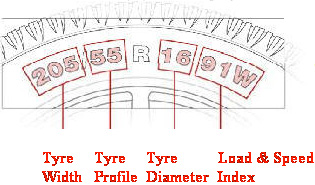How do I know what my tyre width, profile and size are?
 If your tyre showed the displayed numbers in this illustration, your width is 205, your profile is 55 and the tyre diameter is 16. Also, the speed rating is R and the load and speed index is 91W.
If your tyre showed the displayed numbers in this illustration, your width is 205, your profile is 55 and the tyre diameter is 16. Also, the speed rating is R and the load and speed index is 91W.
How can I tell when my tyres need changing?
The fact that tyres wear gradually can make it difficult to identify the reduction in performance, so it’s best to have them checked regularly and preferably by an expert. It is the driver’s responsibility to ensure that the tread on your tyres is not worn beyond the legal minimum limit of 1.6 millimetres. UK law requires that your vehicle is fitted with the correct type and size of tyre for the vehicle type you are driving and for the purpose it is being used. This means fitting the right tyres and for safety ensuring that they are inflated to the manufacturer’s recommended pressure. The legal limit for minimum depth of the tread on your tyres is 1.6 millimetres, across the central ¾ of the tread around the complete circumference of the tyre. For safety reasons it is recommended that you replace your tyres before the legal limit is reached. Many vehicle manufacturers recommend replacing at 3 millimetres.
To make this easier to identify, tyre manufacturers mould tread wear indicators (T.W.I) into the design of the tyres tread pattern usually at a tread level of 1.6mm. As soon as the tread is worn to the height of the tread wear indicator, the tyre has reached the legal minimum tread depth and you should replace the tyre as soon as possible.
You should also be aware that there are many different reasons for tyre wear. Your tyres don’t just get worn through age and use, but through emergency braking, under-inflation or over-inflation. And if your wheels are misaligned, one edge of the tyre can wear more rapidly than the other edge.
We recommend a weekly walk around the car to check the tread, look for bulges or wear and to check tyre pressures every time you fill the tank.

